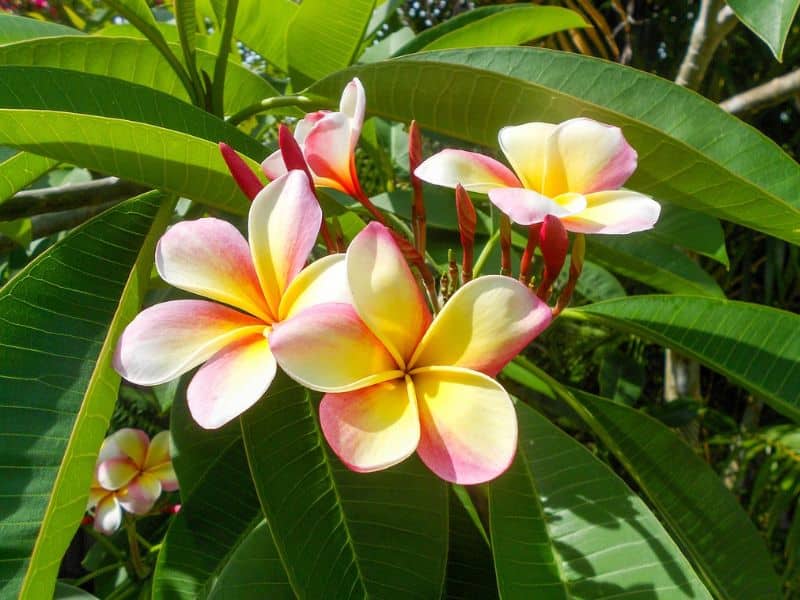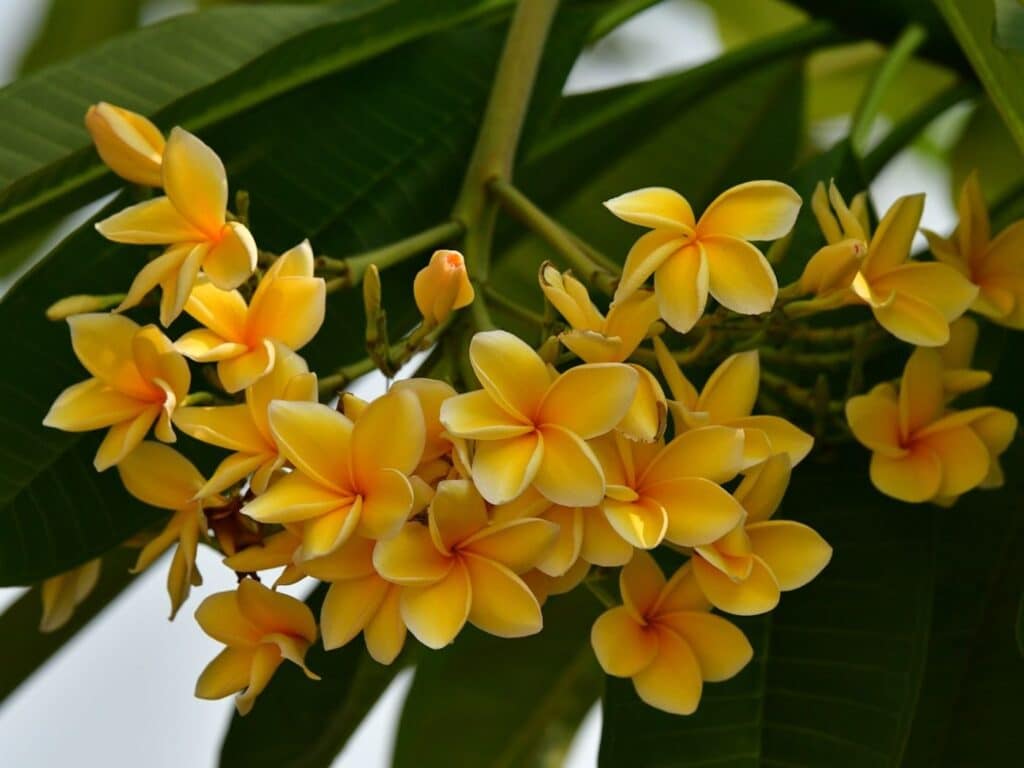Imagine stepping into your garden to be greeted by the vibrant hues and intoxicating fragrance of plumeria flowers. These exotic beauties, synonymous with tropical paradise, can transform any space into a lush retreat.
However, achieving that lush vibrancy isn’t just about planting and watering; it requires a secret ingredient—fertilizer. But not just any fertilizer, one that’s tailored specifically for plumeria flowers.
Navigating the world of fertilizers can be overwhelming, with countless options and recommendations. You want your plumerias to thrive, not just survive.
This is where understanding the right fertilizer comes into play. It’s not merely about boosting growth; it’s about nurturing your plumerias in a way that enhances their bloom, color, and overall health. Let’s dive into the essentials of plumeria flower fertilizer, ensuring your garden becomes the envy of the neighborhood.
Understanding the Nutritional Needs of Plumeria Flowers

The Importance of Macronutrients
Macronutrients are the backbone of plumeria nutrition, essential for their growth and vibrant blooms. Plumeria plants require nitrogen (N), phosphorus (P), and potassium (K) in larger quantities compared to other elements.
Nitrogen supports leaf growth and gives plumeria their lush green color. Phosphorus is crucial for root development and helps in the formation of flowers. Potassium, conversely, aids in overall plant health, improving disease resistance and water regulation.
The Role of Micronutrients
While macronutrients get the limelight, micronutrients play a critical, supporting role in plumeria care. Elements like iron, manganese, zinc, copper, molybdenum, and boron, though needed in smaller amounts, are pivotal for the fine-tuning of plumeria health.
Iron ensures the leaves stay green and vibrant, while manganese aids in the plant’s metabolism. Additionally, zinc is vital for growth hormone production. Together, these micronutrients optimize plumeria’s ability to produce those stunning flowers you love, even as the leaves may occasionally turn yellow due to various factors.
Types of Plumeria Flower Fertilizers
Given the need for specific nutrients to support plumeria growth and bloom, selecting the right type of fertilizer is key. This section introduces various fertilizer options, focusing on organic versus synthetic, and liquid versus granular formulations.
Organic Versus Synthetic Fertilizers
Organic fertilizers come from natural sources like compost, manure, and bone meal. These options release nutrients slowly, improving soil health over time. They’re great for plumerias, fostering strong growth and vibrant flowers.
Synthetic fertilizers, conversely, are man-made and offer a quick nutrient fix. They’re precise, allowing you to manage the nutrient levels your plumerias receive. However, they don’t improve soil structure as organics do.
Liquid Versus Granular Formulations
Liquid fertilizers provide nutrients that plumerias can absorb quickly, perfect for addressing immediate deficiencies. They’re applied with water, making them easy to use during routine watering. However, their effects are short-lived, requiring frequent applications.
Granular fertilizers, conversely, release nutrients slowly as they break down in the soil. This slow release ensures a steady supply of nutrients, reducing the need for frequent re-application. But, granules take longer to impact plant health, so planning is necessary to achieve optimal growth and blooming.
Evaluating the Best Plumeria Flower Fertilizer Options
Choosing the right fertilizer for your plumeria flowers isn’t just about picking any bag off the shelf. It’s about understanding what your vibrant blooms need to thrive. Let’s dive into the specifics of NPK ratios and which brands stand out in the plumeria-care game.
Analyzing NPK Ratios
When it comes to feeding your plumeria, the NPK ratio is like the secret sauce. NPK stands for nitrogen (N), phosphorus (P), and potassium (K), each vital for different aspects of a plant’s growth. Nitrogen promotes leaf growth, making it crucial for plumerias that need strength to support their heavy blooms.
Phosphorus is essential for root development and helps in flower production, ensuring your plumeria’s blooms are as lush and colorful as possible. Potassium, the third component, supports the overall health of the plant, aiding in disease resistance and drought tolerance.
A balanced NPK ratio for plumerias leans towards higher phosphorus levels, such as a 10-30-10 formula. This ratio supports vibrant blooms without sacrificing the plant’s foliage or root health. Remember, too much nitrogen and your plant may well produce more leaves than flowers, so aim for a balance that promotes blooming.
Reviews of Top Fertilizer Brands
Let’s talk brands. With so many options, picking a fertilizer can feel like trying to find a needle in a haystack. Here are a couple of brands that get two thumbs up for plumeria care:
- Dr. Earth Exotic Blend: This organic fertilizer is a go-to for plumeria enthusiasts looking for a more natural approach. Its NPK ratio of 5-5-5 along with probiotics and mycorrhizae makes it a slow-release powerhouse that nurtures your plumerias’ roots, leaves, and blooms.
- Miracle-Gro Water Soluble Bloom Booster: For those seeking instant gratification, Miracle-Gro’s Bloom Booster offers a quick nutrient fix. With an NPK ratio of 15-30-15, it’s tailored to push your plumerias to blossom generously. However, remember, this synthetic option may well not do much for soil health in the long run.
Both these brands have solid reputations and offer different approaches depending on your gardening style. Whether you’re into the slow and steady organic route or prefer a quick nutrient boost, there’s something for every plumeria plant out there. Just remember, moderation is key; too much of a good thing can lead to nutrient burn, affecting your plant’s overall health.
When and How to Fertilize Plumeria Flowers

The Best Time to Fertilize
Timing is everything, and this rings true for feeding your plumeria flowers, especially when growing plumeria from cuttings. Kick off the fertilization process in early spring, as soon as new growth appears. This is when plumeria plants are coming out of their dormancy phase and are hungry for nutrients.
A second wave of fertilization is beneficial in the summer, which supports the blooming phase. Avoid fertilizing in late fall or winter, when plumeria plants are resting and won’t benefit from the added nutrients.
Application Methods and Tips
Choosing the right application method can make a big difference. If you’re using granular fertilizer, sprinkle it evenly around the base of the plant, keeping it a few inches away from the stem, then water it thoroughly to help the nutrients seep into the plumeria soil.
Liquid fertilizers require dilution according to the package instructions before applying them directly to the soil or leaves. This method allows for a more immediate uptake of nutrients but may well need to be applied more frequently.
Here’s a nugget of wisdom: always read the label on your fertilizer package. Over-fertilizing can lead to nutrient burn, which damages the roots and leaves of your plumeria.
Less is often more, so start with a lower dose than recommended and observe how your plant responds. Adjust accordingly, always aiming for healthy growth rather than forcing it. Remember, your plumeria flowers thrive on care and attention, not just nutrients.
Common Mistakes to Avoid When Fertilizing Plumeria
Giving your plumeria the right kind of TLC means knowing what not to do as much as what to do. Let’s dive into some common pitfalls you’ll want to steer clear of to keep your plumeria thriving.
Over-Fertilization and Its Consequences
Going overboard with fertilizer may well seem like giving your plumeria an all-you-can-eat buffet, but in reality, it’s more like a fast track to nutrient burn. This excess can lead to leaf burn, stunted growth, and even death.
Stick to the recommended feeding schedule, usually marked on the fertilizer package, to avoid overwhelming your plants. Remember, more isn’t always better, especially when it comes to feeding your plumeria.
Choosing the Wrong Type of Fertilizer
Grabbing any old fertilizer off the shelf is a bit like picking a suit without knowing your size – it just won’t fit right. Plumerias have specific needs, particularly when it comes to NPK ratios. Using a fertilizer with an inappropriate NPK ratio can prevent your plumeria from blooming as it should.
Make sure you’re selecting a fertilizer geared towards flowering plants, ideally one with higher phosphorus content, to encourage vibrant blooms.
And remember, the earlier sections of this article can guide you through choosing between organic or synthetic, liquid or granular, to match your plumeria’s dining preferences perfectly.
Frequently Asked Questions
What are the essential nutrients for plumeria flowers?
Plumeria flowers require specific macronutrients and micronutrients for vibrant growth, including nitrogen, phosphorus, potassium (NPK), and essential trace minerals.
What is the significance of NPK ratios in fertilizers for plumeria?
NPK ratios, like 10-30-10, are critical for plumeria as they ensure a balanced supply of nitrogen, phosphorus, and potassium, promoting healthy blooms and growth.
Organic vs. Synthetic fertilizers: Which is better for plumeria?
Both organic and synthetic fertilizers have their benefits. Organic fertilizers improve soil health over time, while synthetic fertilizers offer immediate nutrient availability. The choice depends on your plumeria’s needs and your gardening preferences.
What are some recommended fertilizer brands for plumeria?
Dr. Earth Exotic Blend and Miracle-Gro Water Soluble Bloom Booster are highly recommended for their effectiveness in promoting vibrant plumeria blooms and healthy plant growth.
When should I fertilize my plumeria?
Fertilize your plumeria in early spring and summer to coincide with its active growth phase, avoiding fertilization in late fall and winter to prevent nutrient burn and dormancy disruption.
How do I apply granular and liquid fertilizers to prevent nutrient burn?
For granular fertilizers, apply them directly to the soil and water thoroughly. For liquid fertilizers, dilute as instructed and apply to the soil, ensuring the plant is not water-stressed to prevent nutrient burn.
What are common fertilization mistakes to avoid with plumeria?
Avoid over-fertilization, which can lead to nutrient burn, and using fertilizers with incorrect NPK ratios that are not tailored to flowering plants, as these can hinder vibrant blooms and overall health.
Find out what the Plumeria flower means to understand why people love this plant.







